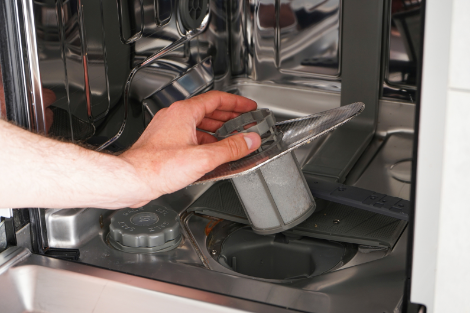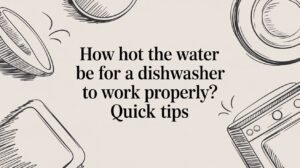A properly functioning dishwasher is essential for any kitchen. Bosch dishwashers are designed to be reliable and efficient, but occasionally, drainage issues can occur. Whether you’re experiencing a problem or need to drain your dishwasher for maintenance, this guide will provide you with the steps to do it effectively.
Why Your Bosch Dishwasher May Not Be Draining
Understanding why your dishwasher isn’t draining is the first step in resolving the issue.
Blocked Drain Hose
The drain hose is responsible for carrying wastewater out of the dishwasher. If it becomes blocked or kinked, the dishwasher may not drain properly.
Clogged Filter
Bosch dishwashers have filters that catch food particles and debris. Over time, these filters can become clogged, preventing proper drainage.
Faulty Drain Pump
The drain pump forces water out of the dishwasher. If the pump is damaged or malfunctioning, the dishwasher may not be able to drain.
Improper Installation
If the dishwasher was not installed correctly, it might cause drainage problems. For instance, an improperly positioned drain hose can prevent water from draining.
Electrical Issues
Sometimes, an electrical fault can cause the dishwasher to stop draining. This could be due to a problem with the control board or wiring.
Tools Needed
Before you start, gather the following tools:
- Screwdriver: For removing parts and accessing components.
- Pliers: To disconnect the drain hose if necessary.
- Towels or Rags: To soak up any excess water.
- Bucket or Shallow Pan: To collect water during manual draining.
Step-by-Step Guide to Drain Your Bosch Dishwasher
1. Safety First
Unplugging the Dishwasher:
- Before working on the dishwasher, unplug it from the power source to avoid electrical shock.
Turning Off the Water Supply:
- Shut off the water supply to prevent any accidental leaks while working on the dishwasher.
2. Check the Drain Hose
Locating the Drain Hose:
- The drain hose is typically found at the back of the dishwasher. You may need to pull the dishwasher out slightly to access it.
Inspecting for Kinks or Clogs:
- Look for any kinks or blockages in the hose. A kinked hose can restrict water flow, while blockages can cause the water to back up.
Disconnecting and Cleaning the Hose:
- Use pliers to disconnect the hose. Run water through it to clear any blockages. Reconnect it once it’s clear.
3. Clean the Filter
Removing the Bottom Rack:
- Pull out the bottom rack to access the filter.
Locating and Removing the Filter:
- The filter is usually located at the bottom of the dishwasher, near the spray arm. Twist it counterclockwise to remove it.
Cleaning the Filter Thoroughly:
- Rinse the filter under running water to remove any food particles and debris.
4. Inspect and Clean the Drain Pump
Accessing the Drain Pump:
- The drain pump is located at the bottom of the dishwasher. You may need to remove the bottom panel to access it.
Removing Debris from the Pump:
- Check the pump for any debris that might be blocking it. Remove any obstructions carefully.
Checking the Pump for Damage:
- Inspect the pump for any signs of wear or damage. If the pump is damaged, it may need to be replaced.
5. Use the Cancel/Drain Function
How to Activate the Drain Function on Your Bosch Dishwasher:
- Most Bosch dishwashers have a “Cancel/Drain” button. Press this button to initiate the draining process.
Observing the Dishwasher to Ensure It’s Draining Properly:
- Listen for the sound of water draining and check the drain hose to ensure water is being expelled.
6. Manual Draining (If Necessary)
Using Towels or Rags to Soak Up Water:
- If there’s standing water inside the dishwasher, use towels or rags to soak it up.
Employing a Bucket or Shallow Pan to Collect Excess Water:
- Place a bucket or shallow pan under the dishwasher to catch any water that drains out when you disconnect the hose.
7. Reassemble and Test
Reattaching Components:
- Once you’ve resolved the issue, reattach the drain hose, filter, and any other components you removed.
Running a Test Cycle to Ensure Proper Drainage:
- Run a short cycle to make sure the dishwasher is draining correctly.
When to Call a Professional if Bosch Dishwasher Not Draining
If your dishwasher continues to have drainage issues after following these steps, it may be time to call our professional technicians. Persistent issues could indicate a more serious problem that requires expert attention. We are experienced in handling Bosch dishwasher repairs and more!
Preventive Measures
Regular Cleaning and Maintenance Tips
- Clean the filter regularly to prevent clogs.
- Check the drain hose periodically for kinks or blockages.
- Run a dishwasher cleaner through the machine once a month to keep it in good working order.
How to Avoid Common Drainage Problems
- Scrape off excess food from dishes before loading them into the dishwasher.
- Avoid overloading the dishwasher, as this can prevent proper drainage.
- Ensure the dishwasher is level to avoid water pooling inside.
Conclusion
Draining your Bosch dishwasher is a straightforward process if you follow the correct steps. Regular maintenance and attention to potential issues can help prevent drainage problems and keep your dishwasher running smoothly.
FAQs about Bosch Dishwasher Drainage Issues
What Should I Do If My Bosch Dishwasher Isn’t Draining?
First, check for common issues like a blocked drain hose or clogged filter. If these are clear and the dishwasher still won’t drain, consider calling a professional.
How Often Should I Clean My Dishwasher’s Filter?
It’s recommended to clean the filter once a month to prevent clogs and ensure proper drainage.
Can I Manually Drain My Bosch Dishwasher?
Yes, you can manually drain your Bosch dishwasher by following the steps outlined in this guide, including disconnecting the drain hose and using towels or a bucket to remove excess water.



